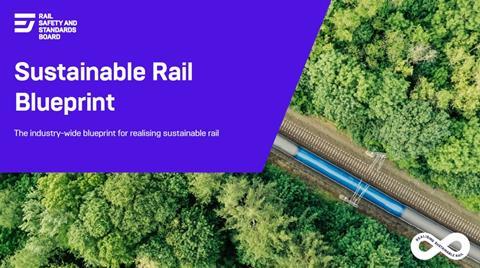
UK: The Rail Safety & Standards Board has launched a Sustainable Rail Blueprint, which it says will support the rail industry in making progress on environmental and social sustainability challenges.
According to RSSB, the industry faces a challenge not just to deliver net zero emissions goals, but also to improve its impact on the environment, local communities and society.
The government identified the need for a cross-industry strategy in 2020, and the Department for Transport has funded development of the blueprint in partnership with other stakeholders.
RSSB says the document ‘is the rail industry’s consensus view’ on sustainability and social benefit objectives. ‘As the industry adapts to changes in passenger and freight demands and changes in rail usage post pandemic, the blueprint will help inform debate and decisions on options, affordability and practicality’, it adds.
Six ‘enablers’
The blueprint covers 11 topics, including emissions, natural environment and social sustainability. It then identifies six ‘primary enablers’ of sustainable rail, before outlining the roles of train operators, infrastructure managers, rolling stock owners, the supply chain, government and regulators in delivering a sustainable rail sector.
The six ‘enablers’ are:
- Zero Emission Traction;
- Seemless [sic] Journeys;
- Nature-Based Solutions;
- Social Value;
- Data Framework;
- Culture for Sustainability.
The blueprint details policy milestones and proposed initiatives that ‘strike a balance between ambition, practicality, and financial pressures’. The focus is on delivering government objectives on carbon reduction, improving air quality, protecting and conserving biodiversity, resources and improving quality of life across Great Britain, RSSB explains.
‘As we look to achieve our net zero goals, this government-commissioned blueprint will become a vital resource for the rail industry, providing clear guidance on what a sustainable railway for the future should look like’, commented Rail Minister Huw Merriman when the report was launched on November 13.
‘While significant progress has already been made in recent years, this report will further support the industry in reducing its environmental impact, using innovative techniques to make our rail network even greener, and ensuring the environment is at the heart of our decision making.’
Faint hopes for electrification
The blueprint gives little succour to those in the industry pushing for Britain to invest in a rolling programme of wiring the main line network, of which currently only 38% is electrified. The document says that setting out a traction decarbonisation strategy is the task of the Great British Railways Transition Team.
‘GBRTT will set out a detailed strategy for the delivery of modern, green train services within its long-term strategy for rail. This includes targeted electrification of lines and maximising the value of alternative rolling stock solutions’, the blueprint explains.
‘While electrified rail lines are the only currently viable solution for the decarbonisation of long-distance, high-speed passenger services and freight, other solutions, including bi-modes, battery, hydrogen and sustainable fuels, are likely to play an increasingly important role.’



